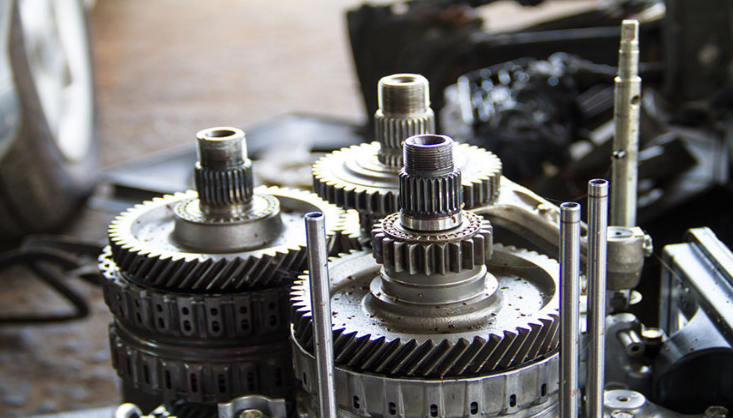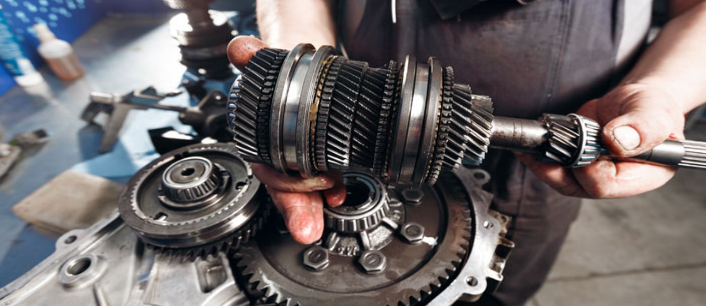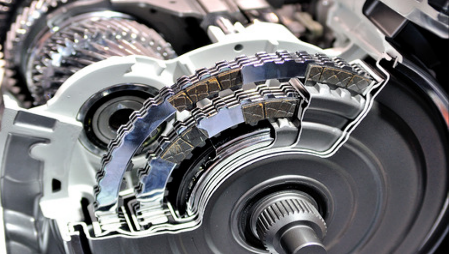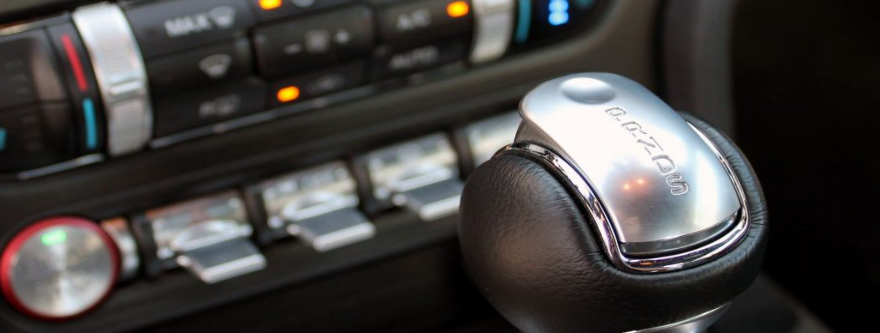Inspect the transmission visually, check for leaks, perform driving tests, review maintenance history, and get a professional mechanic’s evaluation.
Visual Inspection
Checking for External Damage
When inspecting a transmission, begin by looking at its exterior. The casing should be intact without any visible cracks or breakages. Remember, a compromised casing can lead to a multitude of problems internally. Check the mounts and connection points as well, ensuring they’re securely in place.

Possible External Damage Indicators:
- Visible cracks on the transmission casing.
- Bends or dents that suggest an impact.
- Rust or corrosion, especially near connection points.
Looking for Leaks and Stains
Leaks are one of the most common transmission issues. While some might seem minor, they can lead to significant problems if left unaddressed. Start by inspecting the ground where the car is parked for any signs of stains. Then, examine the transmission’s underside, looking for wet spots or dripping fluid. It’s essential to recognize that while a transmission fluid leak is the most obvious, other fluids can impact its performance if they find their way inside.
Places to Check for Leaks:
- Transmission pan seal.
- Fluid lines and connections.
- Input and output shaft seals.
Examining the Transmission Fluid Color and Level
The state of the transmission fluid can tell a lot about the transmission’s health. Start by locating the transmission dipstick, pull it out, and inspect the fluid on it. Fresh transmission fluid is typically a clear red color. If it appears dark or has a burnt smell, it could indicate wear or overheating. Ensure the fluid level is within the recommended range. Too much or too little fluid can harm the transmission’s functioning. Make sure to consult the vehicle’s owner’s manual for the correct procedure, as some modern transmissions don’t come with a dipstick.

Indicators of Fluid Health:
- Bright red and clear: Good condition.
- Dark brown or black with a burnt smell: Possible issues.
- Milky or cloudy: Possible coolant contamination.
Performance Tests
Initial Start-Up Observations
Starting the vehicle can provide essential insights into the transmission’s condition. Pay close attention to the engine’s response during the first few seconds. It should start smoothly without any hiccups or hesitations. The transition from being off to running should be seamless, and there shouldn’t be any abrupt noises coming from the transmission area. This step is crucial because problems during start-up can indicate deeper issues within the transmission system or related components.
What to Listen and Feel for:
- Immediate and smooth engine response.
- Absence of grinding or knocking sounds.
- Quick engagement of the transmission system.
Smoothness During Gear Shifts
As you drive, the transmission should shift between gears smoothly. There shouldn’t be any jerking, slipping, or delays. For manual transmissions, the clutch should engage and disengage seamlessly, allowing for clean shifts. In automatic transmissions, shifts should be almost imperceptible, without any sudden jolts or hesitations.
Shifting Checkpoints:
- Ease of moving the gear lever.
- Absence of grinding noises during shifts.
- Consistent acceleration without unexpected drops in power.
Unusual Noises When in Neutral or During Gear Changes
When the vehicle is in neutral, the transmission should be relatively quiet. If you hear whining, clunking, or grinding sounds, it’s a red flag. Such noises can indicate issues ranging from worn-out gears to problems with the transmission’s internal bearings. Additionally, any unusual sounds during gear changes, especially grinding in manual transmissions, require attention.
Noise Concerns:
- Whining or humming sounds.
- Grinding noises, especially in manual transmissions.
- Loud clunks or thuds when changing gears.
Behavior When Reversing
Reversing is another critical test for the transmission. The vehicle should move backward smoothly, without any hesitation or strange noises. Any jerkiness or delays can indicate problems with the reverse gear or other transmission components. Additionally, listen for any abnormal sounds when engaging the reverse gear, as these can also signify potential issues.
Points of Observation for Reversing:
- Immediate engagement of the reverse gear.
- Smooth and consistent backward movement.
- Absence of grinding or whining noises during operation.
Driving Test
Response to Acceleration
When testing a vehicle, it’s crucial to gauge how the transmission responds to acceleration. As you press the gas pedal, the car should accelerate smoothly without any hiccups. There shouldn’t be any unexpected delays or sudden surges in power. The vehicle’s acceleration should correspond directly with your pressure on the accelerator, allowing you to have full control over the vehicle’s speed.
Acceleration Checkpoints:
- Immediate power delivery when pressing the gas pedal.
- Absence of slipping where the engine revs, but the car doesn’t accelerate proportionally.
- Consistency in power delivery across different speeds and RPMs.

Transition Between Gears While Driving
The hallmark of a good transmission is its ability to seamlessly transition between gears as the vehicle moves. For automatic transmissions, gear shifts should be nearly imperceptible, happening smoothly without any jolts. For manual transmissions, each gear shift should feel crisp, without any grinding or resistance. You should be able to predict and feel the shifts, ensuring a connection between driver and machine.
Gear Transition Points to Observe:
- Smooth upshifts without delays or hesitations.
- Absence of unusual noises or vibrations during shifts.
- Clean engagement and disengagement in manual gearboxes.
Downshifting and Engine Braking Response
Downshifting plays a pivotal role, especially in manual vehicles, for controlling speed and power. When downshifting, the gear should engage swiftly and efficiently, allowing the engine’s braking force to slow the vehicle. Automatic transmissions should also downshift appropriately when needed, such as during a steep descent or when more power is required. Proper engine braking can reduce wear on brake components and enhance vehicle control.
Key Downshifting Observations:
- Quick and efficient gear engagement during downshifts.
- Effective deceleration using engine braking, especially noticeable in manual vehicles.
- Absence of grinding or resistance when changing to a lower gear.
Diagnostic Tools
Electronic Diagnostic Tests
Modern vehicles come equipped with sophisticated computer systems that monitor and control various vehicle functions, including the transmission. To get a precise diagnosis of the transmission’s health, technicians use electronic diagnostic tools that interface with the vehicle’s onboard computer. These tools can read real-time data, analyze transmission performance, and identify potential problems.
Aspects of Electronic Diagnostic Tests:
- Reading real-time data streams related to the transmission.
- Monitoring shift timings and transmission fluid temperature.
- Comparing the current performance data with the vehicle’s baseline specifications.

Identifying Error Codes Related to Transmission Issues
When the vehicle’s computer detects an anomaly in the transmission’s performance, it often triggers a Diagnostic Trouble Code (DTC). These codes help technicians pinpoint specific issues. For instance, a code might indicate a problem with a solenoid or a fluid pressure issue. Interpreting these codes correctly is crucial, as they guide the repair process.
Points to Understand About Error Codes:
- Each code corresponds to a specific issue or anomaly in the transmission system.
- Some codes might be generic, applicable to many vehicle makes and models, while others might be manufacturer-specific.
- Comprehensive OBD-II scanners can read and interpret these codes, guiding technicians to the root of the problem.
Maintenance History
Previous Repair Records
The repair history of a vehicle, especially concerning its transmission, provides vital insights into its current condition and potential future performance. When examining previous repair records, you should look for recurring issues or major repairs, as these can indicate underlying problems or areas of concern.
Points to Review in Repair Records:
- Dates and details of any major transmission repairs.
- Components replaced or refurbished over time.
- Recommendations from technicians from past visits and if those suggestions received attention.
- Cross-referencing any major repairs with vehicle recall databases to see if the issues were widespread.
Frequency of Transmission Fluid Changes
Regular transmission fluid changes play a crucial role in ensuring the longevity and smooth performance of the transmission. Old or contaminated fluid can lead to wear and tear, affecting the transmission’s efficiency. Knowing how often the fluid received changes can help predict the transmission’s current state and longevity.
Transmission Fluid Change Insights:
- Ideal intervals for transmission fluid changes, typically recommended every 30,000 to 60,000 miles, though it can vary based on the vehicle make and model.
- Checking for consistency in adhering to these intervals.
- Analyzing the type and quality of transmission fluid used in previous changes.

Known Issues or Recalls Related to the Transmission Model
Manufacturers sometimes identify issues with specific transmission models after their release. This knowledge can help potential buyers be aware of any inherent flaws or areas of concern. Additionally, understanding if a transmission underwent a recall and if the owner addressed the recommended fixes provides clarity on its reliability.
Aspects to Investigate about Recalls:
- Checking the vehicle’s VIN against manufacturer recall databases.
- Identifying the nature of the recall – whether it was a minor adjustment or a major overhaul.
- Confirming if the vehicle underwent the recommended repairs or changes post-recall.
Professional Inspection
Benefits of a Mechanic’s Evaluation
A mechanic’s expertise can be invaluable when assessing a transmission’s condition. Their experience and knowledge allow them to pinpoint issues that might be invisible to the untrained eye. Moreover, they have specialized tools and equipment to perform thorough tests that can predict potential future problems.
Key Benefits of a Mechanic’s Evaluation:
- Expertise in Identification: Mechanics can recognize signs of wear, damage, or improper maintenance that might go unnoticed otherwise.
- Advanced Diagnostic Tools: A mechanic’s arsenal includes equipment that can provide a detailed analysis of the transmission’s health, beyond what standard tools can offer.
- Informed Opinions: Mechanics can compare the transmission’s state to others they’ve encountered, providing context regarding its performance and longevity.
- Cost Savings: Spotting issues early on can prevent costly repairs down the line. A mechanic can provide insights into potential problem areas, helping you avoid hefty bills in the future. This foresight is crucial, especially when considering transmission repairs, which can be among the most expensive automotive fixes.
Recommendations Based on Professional Assessment
Once a mechanic completes the inspection, they will provide recommendations based on their findings. These suggestions will guide any necessary repairs, maintenance, or changes to ensure the transmission’s optimum performance.
Points to Expect in a Mechanic’s Recommendations:
- Immediate Repairs: If the mechanic identifies any urgent issues, they will recommend immediate action to prevent further damage or malfunction.
- Maintenance Suggestions: Based on the transmission’s current condition, the mechanic might suggest maintenance routines or practices that can enhance its performance and extend its lifespan.
- Replacement Considerations: In cases where the transmission shows signs of significant wear or damage, a mechanic might advise on the costs and benefits of a replacement versus continued repairs.
- Driving Habits: Mechanics can sometimes identify issues caused by specific driving habits. They might offer tips on driving techniques that can reduce wear on the transmission or enhance its efficiency, drawing from their understanding of vehicle dynamics.

Common Signs of Transmission Problems
Slipping Gears
When gears slip, the transmission unexpectedly changes gears while driving, even when you haven’t prompted it. This can be both frustrating and potentially dangerous, as it can lead to a sudden loss of power or unexpected acceleration.
Indicators of Slipping Gears:
- Unexpected Gear Changes: You might notice the vehicle suddenly downshifts or upshifts without any apparent reason.
- High RPMs: The vehicle’s RPM might surge, especially when accelerating, indicating the transmission isn’t shifting gears properly.
- Loss of Power: Despite pressing the accelerator, the vehicle doesn’t pick up speed as it should, hinting at a transmission issue.
- Transmission Fluid Issues: Often, gear slipping can link to transmission fluid problems such as low fluid levels or fluid contamination.
Delayed Response or Hesitation
A well-functioning transmission responds promptly to driver inputs. If you notice a delay between shifting gears or pressing the accelerator and the car responding, it’s a clear sign of transmission problems.
Symptoms of Delayed Response:
- Lag in Acceleration: After shifting gears, especially from “Park” to “Drive” or vice versa, there’s a noticeable delay before the vehicle moves.
- Hesitant Shifting: The vehicle takes longer than usual to shift from one gear to the next.
- Fluid Discrepancies: Transmission fluid that’s burnt or dirty can often lead to delayed responses. Regularly checking and maintaining transmission fluid health can prevent such issues.
Unusual Sounds or Vibrations
The transmission should operate relatively silently. Any unusual sounds or vibrations, especially when shifting gears, indicate underlying issues.
Common Noises and Vibrations Indicating Problems:
- Grinding Noises: Particularly common in manual transmissions, a grinding sound when shifting gears is a red flag.
- Whining or Humming: These noises in automatic transmissions can signal problems.
- Rattling or Clunking: Sounds that emerge when the vehicle is in neutral might point to transmission issues.
- Vibrations During Acceleration: Feeling vibrations or shudders when accelerating can be linked to transmission problems, especially if these sensations align with gear shifts. Familiarity with normal vehicle noises can help discern anomalies.
